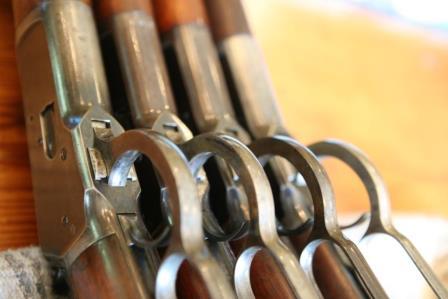I recently purchased a really nice 61 22 Magnum. After doing my standard inspecting and light cleaning, I noticed, in certain lighting conditions and at just the right angle, the left side shows wavy lines. The right side shows a consistent even finish. Any ideas as to what would cause this oddity in the finish? The markings (stamping) are crisp and proud and I see no signs of polishing. I hope the pictures will show what my concern is. The serial #348872. With all the faked 61s showing up I am curious. I don’t want to misrepresent the gun, though I am planning on keeping it. Thanks for your expertise. RDB
There is no unevenness. I just found that the right side also has some of the “discolored” wavy marks. More of a light and darker finish. Unless you tilt the receiver it is not noticeable. The finish of the overall gun would rate about 98% with just a few light marks from where the slide rubs on the lower part of the barrel. I wonder if it might have been wrapped in some kind of material that drew moisture, though there are no signs of any rust or corrosion. Just checked the Ned Schwing book and discovered this serial number to be towards the very end of production. Perhaps it wasn’t carefully inspected?
Im certainly no expert but, I dont see any signs of it having been refinished. Like you said, the lines are crisp. If some kind o wrap etched the metal, I would think it would have damaged the bluing. I think it was a quick metal prep job by Winchester prior to bluing but, I think it looks fine myself.
I am now wondering if it slipped through Winchesters quality control due to the end of production. But, since I own it, I may biased and am searching for justification of an explanation of a flawed piece. Yea, that’s a good possibility. I do love and cherish unusual Winchesters! RDB
Interesting rifle! I am inclined to think that the striations are actually chemical/alloy segregation in the base metal. The receivers were forgings from C1120 steel, which is a very soft mild steel with sulfur added to improve the machinability of the metal. I believe the forging blank or blanks probably did not have a good mix, and consequently left areas with varying alloying of the base materials. During the process of forging, the lines would become wavy and follow the the material flow from the forging process. These were later liquid carburized as well which would most likely exacerbate the problem. After polishing/bluing, the different alloying elements would color differently. Without having receiver in hand it is tough to tell for sure. Another and more simple possibility, is that the receiver was not secure or fed through the belt sanding/finishing process in a straight manner causing the waves.
Steve
seewin said
Another and more simple possibility, is that the receiver was not secure or fed through the belt sanding/finishing process in a straight manner causing the waves.Steve
I’m inclined to agree with this scenario, especially as you describe having to hold the receiver at different angles to see the imperfection. Again, a best guess.
Erin
1 Guest(s)


 Log In
Log In Members
Members Home
Home

 Add Reply
Add Reply Add Topic
Add Topic Offline
Offline











